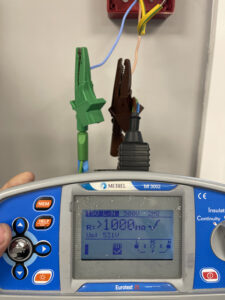Dr Tom Brookes, Managing Director of Zzeus Training and Chair of the Fire & Security Association, provides insight into fire cable installation, and explains why correct insulation and continuity testing is so important – not least because of the requirements laid out in British Standards.
Many people in the fire industry may be forgiven for thinking that fire alarm cable installation and testing are further down on the scale of importance.
In contrast, in the 60s and 70s, fire alarm systems were usually installed by time-served electricians. Since the 1990s, however, it has become common practice to only teach the theory side of fire alarm systems and then issue advanced fire alarm installer certificates from this.
When you look in the British Standard of commercial fire alarm systems BS 5839-1:2017, Section 4 of the book entitled ‘Installation’, only has three out of 48 clauses, so you could be forgiven for thinking it is not as essential.
This is where many engineers, technicians and company owners need to be made aware.
There is another standard that the installation of fire systems must also comply with: BS 7671 Requirements for Electrical Installations — IET Wiring Regulations. Here, it is documented 16 times in BS 5839-1 that BS 7671 needs to be complied with.
At our training centre in Lincoln, we find that the companies who use us for training are looking to enhance their engineers’ skill level and be the best they can be, including assessing practical skills.
So, on day three of our five-day course, we focus on installation and pose the question in every class: ‘only three clauses on installation in the standard, is it not important?’
We carry out physical cable testing detailed in clause 38. However, it has become very apparent that even the big players in the industry only have a select few that have a multifunction cable tester as part of their standard tool kit, yet every single metre of fire cable installed in any building should be tested with one.
What is a multifunction tester? And why is it so important to test?
It’s a cable-testing device that ensures that after you have installed it, the cable is:
- Intact from the fire control panel to each device
- Insulation tested to ensure that the cores of the cables are not touching or arcing with each other and that the cable insulation has not been damaged during the installation stage
I often hear that the fire control panel will tell you if there is a fault, which it may do to a certain extent, but it doesn’t tell you where the fault is, and whose fault it is.
Let’s look at an example…
2,000m of fire cable has been installed:
- Engineer A) tests all the cables and gets all the readings back as ‘perfect’.
- Engineer B) does not bother to test, thinking the panel will pick it up.
Three months later, at a second fix, there is a problem:
- Engineer A) can prove their cable was perfect and that someone else has damaged the cable from their readings. They can also ascertain that a particular section of cable now has a fault caused by someone else.
- Engineer B) has no idea if it’s a system fault, a cable fault, or a device fault because they have no idea if the cable was ok in the first place.
What happens next:
- Engineer A) can charge for fixing the damaged cable because they can prove it was in good condition when installed.
- Engineer B) has zero proof that the cable they installed was ok in the first place, and what is worse is that they have not conformed to the BS 5839-1, so the customer could potentially claim in civil court that BS 5839-1 had not been adhered to as per the contract and claim damages.

Testing insulation resistance at 500 VDC
In clause 38.1, the standard is clear that all cables (and it states ALL cables) are suitable for mains use (that’s all-fire cable) and should be subjected to insulation testing at 500 Vdc between all conductors and earth and should achieve at least 2 MΩ.
Do you do this? If not, your system is non-compliant with BS 5839-1, and if you have signed your paperwork as compliant with BS 5839-1, you may be on thin ice.
What is insulation resistance testing?
Cable insulation is an essential protective material for cable conductors. It is non-conductive, used to resist electrical leakage, prevents cable conductors from contact with other conductors, and protects the conductor from environmental threats such as heat, water, and chemicals.
Poor or damaged insulation may result in short circuits, electric shocks, or fire. An insulation resistance (IR) test measures the resistance to current flow across it on a completed cable; it applies a test voltage to determine how effective the insulation is in preventing the flow of electric current out of the insulation.
What is continuity testing?
Continuity testing measures the resistance between two points in ohms. Low resistance means that the circuit is closed and there is electrical continuity. High resistance means that the circuit is open, and continuity is lacking. Continuity testing can also help determine if two points are connected that should not be.
Source: IFSEC GLOBAL


